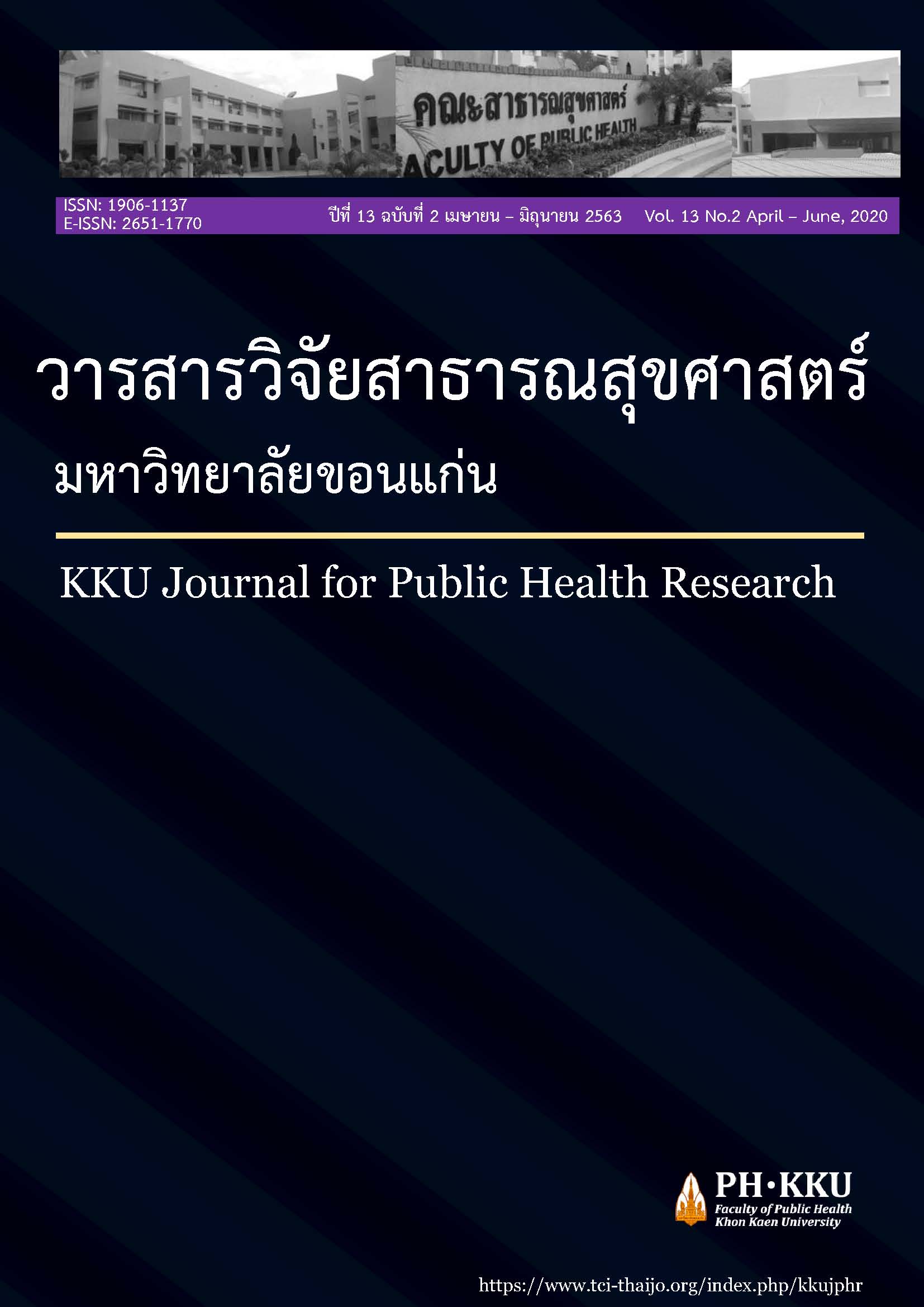Prevalence of Anemia and Factors Related to be Able to Donate Blood among Female University Students, Nakhon Ratchasima Province
Keywords:
anemia, being able to donate blood, female university studentAbstract
This research aimed to determine prevalence of anemia and to identify factor associated with being blood donor among female students, Suranari Technology University, Nakhonraschasima Province. Participants were 279 female students voluntarily donating blood to Thai Red Cross. Data were collected by means of questionnaires consisting of 4 parts including 1) personal information 2) health status 3) food consumption 4) hemoglobin concentration and blood donation. Anemia was defined as Hb <12 g/dl and those who were able to donate blood are Hb >=12.5 g/dl. Data were analyzed using descriptive statistics, Chi-square test or Fisher exact test and backward multiple logistic regression and presented as frequency, percentage, mean, standard deviation, median, inter quartile range, crude Odds ratio, adjusted Odds ratio and 95% CI.
The results showed that prevalence of anemia was 25.4%. The rate of being able to donate blood was 64.5%. According to the analysis of the relationship, it was found that the body mass index (BMI) and consumption of sesame seeds associated with blood donation in female students statistically significance (p-value= 0.010, p-value=0.024, respectively). Overweight people (BMI 23 kg/sq.m. and over) had a chance to donate 1.99 times (ORadj=1.99, 95% CI; 1.18–3.38) comparing with those with BMI less than 23 kg / sq.m. And, those who ate sesame seeds >=1-3 times/week had a 2.59 times the chance of being unable to donate blood (ORadj= 2.59, 95% CI; 1.13–5.91) of those eating sesame seeds <1-3 times/week. To reduce anemia and increase the number of people who can donate blood, health education and food choices information should be provided in particularly the consumption of foods high in iron and foods enhancing and inhibiting iron. Moreover, iron supplements should be given to the students with anemia. These not only help to reduce anemia, but also there will be more people who can donate blood resulting in an increased chance of surviving of patients.
References
กฤตกรณ์ ประทุมวงษ์, รุ่งโรจน์ พุ่มริ้ว, & ปรีชา ลอเสรีวานิช. (2558). ปัจจัยพฤติกรรมและการตัดสินใจ ในการบริจาคโลหิตของบุคลากร มหาวิทยาลัยกรุงเทพธนบุรี. ค้นจาก https://bkkthon.ac.th/home/user_files/department/department-24/files/3-57.pdf
คณะกรรมการจัดทำข้อกำหนดสารอาหารที่ควรได้รับประจำวันของคนไทย. (2546). ปริมาณสารอ้างอิงที่ควรได้รับประจำวันสำหรับคนไทย พ.ศ. 2546. กรุงเทพฯ: องค์การสงเคราะห์ทหารผ่านศึก.
คณะทำงานพัฒนาสุขภาวะนักศึกษามหาวิทยาลัยเทคโนโลยีสุรนารี. (2561). รายงานการประชุมคณะทำงานพัฒนาสุขภาวะนักศึกษามหาวิทยาลัยเทคโนโลยีสุรนารี ครั้งที่ 4/2561. นครราชสีมา: ส่วนกิจการนักศึกษา มหาวิทยาลัยเทคโนโลยีสุรนารี. (เอกสารอัดสำเนา)
คณะอนุกรรมการสังเคราะห์องค์ความรู้ด้านอาหารและโภชนาการสำหรับผู้บริโภค. (2559). องค์ความรู้ด้านอาหารและโภชนาการสำหรับทุกช่วงวัย. นนท์บุรี: สำนักอาหารสำนักงานคณะกรรมการอาหารและยา.
ธนารีย์ มีมุข, วิลิวัลย์ แซกรัมย์, นิภาวรรณ ยุทธยศ, พิชชานันท์ คำสว่าง, เกรียง-ศักดิ์ ไชยวงค์, & สิณีนาฏ อุทา. (2559). ผลการตรวจสุขภาพของผู้บริจาคโลหิตที่เข้ารับบริการที่งาน Donor Care ณ ศูนย์บริการโลหิตแห่งชาติสภากาชาดไทย ประจำปีงบประมาณ 2558. ใน การประชุมวิชาการงานบริการโลหิตแห่งชาติ ครั้งที่ 24 ประจำปี พ.ศ. 2559. (หน้า 266) กรุงเทพฯ: ศูนย์บริการโลหิตแห่งชาติ สภากาชาดไทย.
ธนิดา บุตรคล้าย . (2544). ทัศนคติต่อการบริจาคโลหิตและพฤติกรรมเสี่ยงของนิสิต นักศึกษาระดับปริญญาตรีของมหาวิทยาลัยในส่วนภูมิภาคที่เกี่ยวข้องกับการบริจาคโลหิต. วิทยานิพนธ์ปริญญาวิทยาศาสตรมหาบัณฑิต สาขาวิชาเวชศาสตร์ชุมชน คณะแพทย์ศาสตร์ จุฬาลงกรณ์มหาวิทยาลัย.
ปฏิชญา ชัยศรี, กิ่งแก้ว พิมพ์ดี, อรวรรณ พรามดิ่ง, มัทนา จุลท่าหว้า, & วิราศิณี ชัยมณี. (2559). การศึกษาเปรียบเทียบผู้บริจาคโลหิตที่มีความเข้มข้นโลหิตต่ำกว่าเกณฑ์มาตรฐาน ปี 2556-2558 ภาคบริการโลหิตแห่งชาติที่ 6 จังหวัดขอนแก่น. วารสารโลหิตวิทยาและเวทศาสตร์โลหิต, 26(3), 267.
พนารัตน์ บุญฤทธิการ. (2542). ปริมาณวิตามินซีที่มีผลต่อการเพิ่มธาตุเหล็กที่ดูดซึมได้ในอาหารที่มีเส้นใยและไฟเตท โดยการศึกษาในหลอดทดลอง. วิทยานิพนธ์ปริญญาวิทยาศาสตรมหาบัณฑิต สาขาวิชาโภชนวิทย. บัณฑิตวิทยาลัย มหาวิทยาลัยมหิดล.
พรชนิตว์ ตั้งสุวรรณโสภิณ. (2557). ความชุกและปัจจัยเสี่ยงต่อภาวะเลือดจางในนักศึกษาหญิงระดับอุดมศึกษา จังหวัดขอนแก่น. ขอนแก่น: คณะสาธารณสุขศาสตร์ มหาวิทยาลัยขอนแก่น.
พิมล เชี่ยวศิลป์. (2012). มาตรฐานการเฝ้าระวังภาวะแทรกซ้อนที่เกี่ยวกับการบริจาคโลหิต. วารสารโลหิตวิทยาและเวชศาสตร์บริการโลหิต, 22(3), 161-164.
ศุภิสรา วรโคตร, ผ่องศรี เถิงนำมา, นันทา ศรีนา, & ปราณี ธีรโสภณ. (2554). ผลการพัฒนาแบบคัดกรองภาวะโลหิตจางเบื้องต้นในหญิงวัยเจริญพันธุ์โดยอาสาสมัครสาธารณสุข ตำบลจันท์เพ็ญ อำเภอเต่างอย จังหวัดสกลนคร. การพยาบาลและการศึกษา, 4(2), 2-9.
ศูนย์บริการโลหิตแห่งชาติ สภากาชาดไทย. (2557). รายงานการปฏิบัติงานและผลงานประจำปี 2556 ศูนย์บริการโลหิตแห่งชาติ สภากาชาดไทย. กรุงเทพฯ: ศูนย์บริการโลหิตแห่งชาติ สภากาชาดไทย.
ศูนย์บริการโลหิตแห่งชาติ สภากาชาดไทย. (2559). คู่มือการประชาสัมพันธ์ โครงการและกิจกรรมรณรงค์จัดหาผู้บริจาคโลหิต ประจำปี 2559. ศูนย์บริการโลหิตแห่งชาติ สภากาชาดไทย.
อรุณ จิรวัฒน์กุล. (บรรณาธิการ). (2557). สถิติในงานวิจัยเลือกใช้อย่างไรให้เหมาะสม. กรุงเทพฯ: วิทยพัฒน์.
Kraemer, K. (Ed.). (2007). Nutritional anemia. Switzerland: Sign and life.
National Blood Centre, Thai Red Cross society. (2008). Standards for blood and transfusion services. 2nd ed. New Delhi: National AIDS Control Organization.
World Health Organization. (2008). Worldwide prevalence of anemia 1993-2005: WHO global database on anaemia. Geneva: WHO Press.
World Health Organization. (2012). Global database on blood safety: Summary report 2011. Geneva: WHO.


